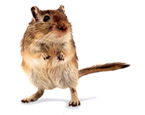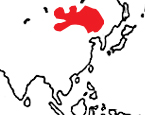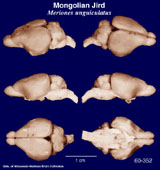|
Mongolian
Jird (Gerbil)
(Meriones unguiculatus) #60-352 |
||||
|
|
Physical
characteristics and distribution
|
|
Head
and body length of M.unguiculatus range from 95-180 mm
and tail lengths are 100-193 mm. Weights of captive individuals
have been recorded at 50-55 grams for females and 60 grams for
males. The pelage is soft and fairly dense with a wide variety
of color variations. Upperparts can be clear yellowish, sandy
gray to brown. Underparts are lighter ranging from buffy white
or pale gray. Their
diet consists of green vegetation, roots, bulbs, seeds, cereals,
fruits, and insects. |
|
Description
of the brain
|
|
Animal
source and preparation
|
|
|
List of Specimens | Explore Collections | Brain Sections | Brain Evolution | Brain Development | Brain Circuitry | Brain Functions | Location and Use | Related Web Sites | Contact Us | Search MSU Database | Personnel | Home



